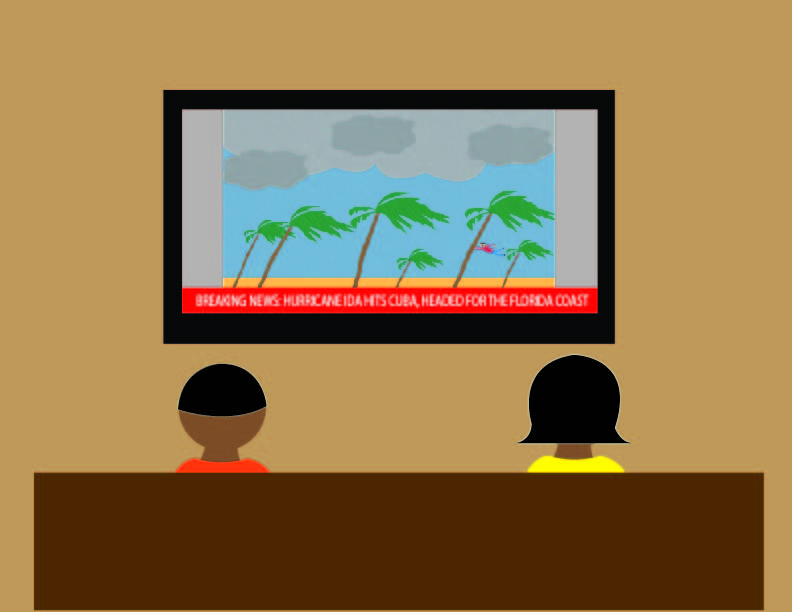The Wrath of Hurricane Ida
October 7, 2021
The ninth named storm, fourth hurricane, and second major hurricane of the 2021
Atlantic hurricane season, Ida originated from a tropical wave in the Caribbean Sea on Aug. 23.
Hurricane Ida was classified as a catastrophic Category 4 Atlantic hurricane, the second-most
damaging hurricane to ever strike Louisiana, behind Hurricane Katrina. Ida was the sixth
costliest tropical hurricane on record, causing at least $50 billion in damages.
On Aug. 29, 2021, the 16th anniversary of Hurricane Katrina, Hurricane Ida struck
Louisiana as a Category 4 hurricane, exhibiting 150 mph winds, and obliterating almost
everything in its path. Remembering Hurricane Katrina, Chris Walcott, a former civil engineer,
stated, “Katrina was much larger in area. It had high winds that extended hundreds of miles from
the center. Those, because of the large area, pushed more water onto land (storm surge) and that
made Katrina a much more devastating storm than Ida, even though Ida had a higher top wind
speed.” On Aug. 26 the wave developed into a tropical depression, which became Hurricane Ida
later in the day near Grand Cayman. Mixed with the right conditions, Ida intensified into a
hurricane on Aug. 27, before moving over western Cuba, knocking down palm trees and
ravaging many homes during its passage. The hurricane underwent transformation over the Gulf
of Mexico, and reached peak intensity while approaching the northern Gulf Coast, with
maximum sustained winds of 150 mph. IHS Astronomy teacher Jake McKinzie says the high
wind speed in New Orleans meant that, “anything not nailed down is gone, with everything else
flattened.” Ida began to weaken over land, downgrading to a depression on Aug. 30, with
sustained winds of about 35 miles per hour as it moved north over Mississippi. On Sept. 1, Ida
transformed into a post-tropical hurricane, accelerating through the northeastern United States
and breaking multiple rainfall records in various locations before ultimately moving into the
Atlantic the next day.
Following Katrina, which struck as a Category 3 hurricane, an estimated 2.7 million
customers were left without power in Alabama, Florida, Louisiana, Mississippi and Texas. The
New Orleans levee system, built to protect the metro area after Hurricane Katrina, held with no
reports of major breaches of the levees and floodwalls. Regarding the newly rebuilt levee system,
McKinzie says, “It is comparable to a five year old building a wall of sand on the beach to
protect their sand castle. We can hold them together until nature gets involved.” Despite
widespread power outages, pump systems continued to expel excess water. Some of the
devastated areas faced power outages for weeks, though 90 percent of customers had their power
restored sooner. In addition, the hurricane damaged substations and transmission lines in New
Orleans and surrounding parishes, and traveling more than a block posed a threat due to fallen
utility poles, power lines, oaks and cypresses. However, with generators running, people cleared
yards of tree limbs, shingles, and carport roofs.
Hospitals that were already strained by a resurgence of COVID-19 cases in Louisiana
suffered roof damage and water leaks from Ida’s winds and slow movement. For example, the
Ochsner Health hospital system had to evacuate 65 patients from two Louisiana hospitals in
Raceland and Houma. Having faced similar issues, regions with no working towers quickly
found a way to connect in areas where wireless carriers had set up emergency cell sites. Backup
batteries and generators kept service online for a day or more until authorities restore power to
the electrical grid. Eight transmission lines that delivered electricity into New Orleans were out
of service, including one spanning the Mississippi River that was downed by Ida. Entergy
managed to quickly repair badly damaged towers on one remote line by airlifting towers from
another line. Sophomore Riley Marinos says that she could withstand these conditions, “before I
went crazy, seven and a half days.”
President Biden said more than 5,000 members of the National Guard had been activated
towards the states hit by the storm and noted that former Louisiana congressman Cedric
Richmond, served as a direct White House contact for leaders in the region. When asked what
the government should be doing in response, senior Grace Alawi states, “The priority is fixing
climate change, giving money, and rebuilding structures.” More than 300,000 customers in
Louisiana lacked water, and another 300,000 were under boil-water advisories, according to the
Louisiana Department of Health. About 3,000 customers in coastal Mississippi had boil-water
alerts, according to the Mississippi State Department of Health. In New Orleans, about 80 of 84
sewer pumping stations lost power, creating the potential for backups, said the Sewerage and
Water Board. The utilities relied on generators to start powering the stations back up, and
meanwhile, residents had to limit water usage. Additionally, when asked what the future for New
Orleans holds, Walcott states, “Serious thought must be given to the long term viability of
Southern Louisiana.”
After the Big Easy and Gulf Coast took a beating, popular tourist destinations have
looked better. In Nashville, Tennessee, weather and flooding from the hurricane forced
organizers to cancel Bonnaroo, the popular country music festival held outside of Nashville.
They were also hit by flash floods during the storm, the National Weather Service reporting that
the city saw nearly two and a half inches of rain every half an hour, as well as high wind speeds
and major power outages. Jersey Shore, New Jersey was battered by severe thunderstorms, heavy
rainfall, widespread flooding and even isolated tornadoes. The state’s beach towns were
primarily impacted by flooding, but they escaped the damage that storms like Hurricane Sandy
have caused. As Hurricane Ida continued on its path through the northeast, Massachusetts was
one of the last states hit and dealt with a lower level of severity. In Cape Cod, Massachusetts,
there were also widespread power outages overnight, but the turnaround was quick. In Virginia
Beach, Virginia as Hurricane Ida looped up towards the Atlantic Ocean, the southwest side of
Virginia was dumped on by rain and wind, but popular vacation town Virginia Beach’s
southeastern corner escaped damage, falling just outside of the storm’s path. Walcott warns,
“Miami is bigger and wealthier, with more potential for damage. After future storms, rebuilding
may not be practical along the Mississippi River.” Hurricane Ida’s path of destruction continues
to be repaired, with many lives transformed and many others nervously anticipating what comes
next. While the south and northeast brace themselves for the next disaster, politicians and
citizens alike are beginning to doubt the prosperity of New Orleans. It would be a national loss of
history, but a sobering testament to the force of nature.




